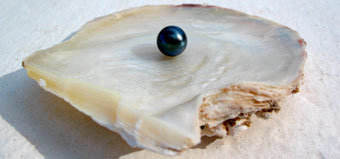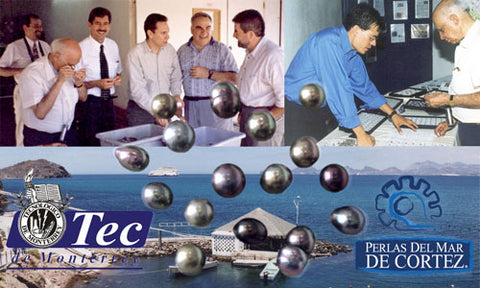The fame of Mexican pearls increased even further when an important development took place in the Island of "Espíritu Santo" (near the City of La Paz), in the southern part of Lower California (Baja California Sur). This development took form as a company founded by Medical Doctor Gastón Vivès, who started the world's first commercial pearl oyster culture farm, this back in the year of 1893. At this farm, he was able to grow some 8 to 10 million black-lipped pearl oysters (Pinctada mazatlanica) and employ over 1,000 workers.

He was very successful at collecting "spat" (baby oysters), rearing and developing his black-lipped oysters (Pinctada mazatlanica) for several years, and then harvesting them. The company's main product was the mother-of-pearl shell, but he was able to obtain many natural pearls (non-cultured) inside his oysters (an estimated 9-14% of his oysters grew natural pearls).

If you consider the fact that most modern pearl farms obtain only about 20% of commercial quality cultured pearls, you can begin to imagine Mr. Vivès most extraordinary feat. And, this took place sometime before the Japanese began Culturing Pearls commercially.
How Mexican Pearls became a Legend of Old
Unfortunately, in 1914 the pearl farm was destroyed and the company's safe was looted during the attack of the Constitutionalist Army to the city of La Paz. After the Mexican Revolution was over, Mr. Vivés tried -in vain- to obtain an indemnification to his losses and rebuild the pearl farm. This unique and successful attempt at growing pearl oysters, the first commercial venture in the field in the entire planet, closed a chapter...

After the destruction of the "Compañía Criadora de Concha y Perla", pearls had to be obtained solely by the means of nude diver armadas. A huge effort was done on the part of the armadores (owners of the pearl fishing fleets) and their divers.
Yaqui and Seri Indians were considered to be the best pearl divers available, diving down to depths of 15 meters (around 50 ft) in order to fish those oysters that had been left undisturbed because of the perilous depths...but as the fishing intensified, fewer pearls were obtained.
Later on came the helmeted divers, fishing for oysters at depths of over 20 meters (60 ft), and pearls once more started ebbing out of the waters. By the 1940's no more pearls came out of the waters around Baja California, those that were found came from Sonoran waters thanks to the Seri Indian fishery around "Isla Tiburón". Finally -after 450 years of overfishing- the pearls from the Sea of Cortez became a legend of old...
A Lost Opportunity
Mexican pearls are born out of two native Pearl Oyster species: the "Panamic Black-Lipped Pearl Oyster" (Pinctada mazatlanica) and the "Rainbow-Lipped Pearl Oyster" (Pteria sterna).

Both organisms are quite able of producing pearls in a wide array of colors: from an opalescent white, golden-bronze, grays, greens and blues, pinkish-violet, and all the way to jet black.
As a matter of fact, some Mexican pearls do hold some similitude to their Tahitian counterparts, although some Pearl Specialists (such as Hubert Bari of France, the late C. Denis George of Australia and Sohei Shirai of Japan) consider Mexican pearls to be Superior, because of their beautiful luster and unique overtones/orient.
Mexico lost the great opportunity of becoming the leading country in the culture of naturally colored (black) pearls. The factors involved in this were many, but bad government practices and decisions were decisive.
It was back in the decade of the sixties when a pilot pearl culture station was started in the Falsa Bay, South Baja California, with the help of Australian Pearl Promoter: C. Denis George.

Mr. George had even started training a Mexican seeding technician when the farm was seized by the State Government, the pearls confiscated and -sometime later- the pearl farm was closed forever.
A few years later, French Polynesia was exporting black pearls...and Mexico was not.
Pearl Revival
During the 1970's and 1980's, a rebirth of scientific studies related to pearl culture took place in Mexico. Unfortunately, due to the unpopular measures were undertaken by previous Mexican Governments, no interest was generated among possible investors. Another factor influencing this lack of interest was that research was never oriented to determine a productive technology needed in order to develop a modern and feasible commercial venture.
Mexico would have to wait until 1994 (some 80 years after Vivès) when the experimental pearl culture program started at the Guaymas Campus of the ITESM (Instituto Tecnológico y de Estudios Superiores de Monterrey) initiated the development of applied commercial technologies.
By 1995, some 5,000 cultured half-pearls (mabe pearls) and the first cultured -a major breakthrough in Pearl Culture- pearls were obtained at the small pilot-scale culture facilities.

These highly positive results -and in so short a time- led to the development of the First Commercial Pearl Farm in the American Continent in 1996, with the production of 30,000 mabe pearls that same year.
Nowadays, Perlas del Mar de Cortez is the sole producer of cultured loose & mabe pearls in the Region. Our pearl farm is located inside a beautiful and tranquil bay known as Bacochibampo Bay, in the City of Guaymas, Sonora.
The estimated yearly production for this pearl farm is of about 4,000 cultured pearls and 5,000 Mabe. This makes Mexican pearls the rarest Cultured Pearls in the World...

